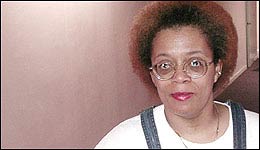 |
| Earl Washington after his exoneration
and release (Photo courtesy Barry Weinstein) |
Earl Washington spent nearly 18 years in
prison, including almost 10 years on
death row, and came within nine days of
being put to death in Virginia's electric chair. Washington says
he could hear the guards preparing it for him. "You heard a
humming," says Washington, "because they tested the chair
every day."
Years later, DNA evidence proved he was innocent, and after another
uphill legal fight, 17 years and nine months after going to jail,
he was set free. Washington had been convicted largely on a single
piece of evidence: his own confession to the rape and murder a
19-year-old mother of three from Culpepper, Virginia. His defenders
say the confession was coerced, and that police took advantage
of a mildly retarded man whose strategy of coping in the world
was "to get along, you go along."
In the end, DNA evidence proved he was innocent, but the state
has still not given any compensation for the years they took from
him. "Only thing I really want is someone to apologize for
what happened," says Washington with a note of weariness.
"Looks like they won't." Read
the full story...
DNA has exonerated many, but there has never been a proven example
of someone innocent being put to death. Many opponents of capital
punishment believe that a vial of evidence held in the lab of
forensic scientist Ed Blake in California might be the first real
proof that one man was killed in the face of scientific proof
of his innocence.
Roger Coleman was convicted of raping and murdering his sister-in-law.
His inexperienced lawyers failed to present all the evidence,
and a clerical error kept him from winning an appeal. He was electrocuted
in 1992.
Now, modern DNA techniques can prove his guilt or innocence,
but the state of Virginia argues the "doctrine of finality,"
and wants no further inquiries in the case.
The decision to test or not is now in the hands of the Virginia
Supreme Court. Scientist Ed Blake says he will not test it without
the court's permission, but he also says that he will not send
it back to Virginia, whatever the court decides. "Nobody
can force me to send it back," Blake says defiantly. "At
issue here is the public's right to know." Read
the full story...
(UPDATE: DNA tests conducted in January 2006 confirmed the original guilty verdict in this case. Click here for more on this story.)
 |
|
 |
|
| (Photo
Jennifer Linzer) |
|
(Photo
Jennifer Linzer) |
|
|
Ford Heights Four:
Kenneth Adams was one of the "Ford Heights Four,"
convicted on what was later discovered to be a coerced confession.
After spending almost two decades in prison, he was released.
The sheriff's department settled with the four for $36 million,
the largest such settlement in history.
Read...
|
|
Coerced Testimony:
Paula Gray was 17 years-old, and borderline mentally retarded.
After being questioned over two nights by police, she testified
that she had watched Verneal Johnson, Williae Rainge, and
Dennis Williams rape and murder a woman, and shoot another
man. It was later shown that her confession was coerced
by police.
Read...
|
|
 |
|
 |
|
| (Photo
Jennifer Linzer) |
|
(Photo
Jennifer Linzer) |
|
|
The Dream Murder:
Steven Linscott approached Oak Park police at the urging
of friends and told them about a dream he had about a similar
murder. Although there were relatively few and not-at-all-amazing
similarities between the dream and the actual crime, authorities
called Linscott's statement a confession and charged him
with murder and rape.
Read...
|
|
Exoneration, Without DNA
Without DNA evidence, it is much harder to win exonerations
for the wrongfully convicted. Gary Gauger was charged with
the murder of his parents at their farm, where they operated
a motorcycle shop. After an all-night interrogation, he
made statements that police claimed constituted a confession.
Police misconduct led to his being set free, and after an
FBI wiretap, police charged a motorcycle gang with the murder
of Gauger's parents. Read...
|
|
Home
| Death Row Stories | Science
of DNA | Law & Politics
Inside Out | Credits
| WBUR








